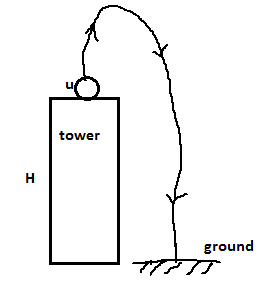Question
Question: A ball thrown vertically upwards with a speed of 19.6 m/s from the top of a tower returns to the ear...
A ball thrown vertically upwards with a speed of 19.6 m/s from the top of a tower returns to the earth in 6s. What is the height of the tower?
Solution
We know that in the case of a vertically projected body, velocity is maximum at the projection point, velocity goes on decreasing and becomes minimum (zero) at the highest point.
Formula used:
Height of the tower, H=21gt2−ut
u is the initial velocity of the body,
Time of travel=t
Complete step by step solution:
Consider a tower of height H. suppose a body is projected upwards vertically with initial velocity u from the top of the tower. Suppose it reaches a displacement x above the tower and thereafter reaches the foot of the tower.

Let t be the total time of travel.
Now considering the total path of the body, the motion parameters are as follows:
Initial velocity of the body=u
Net displacement of the body =S=+x−x−H=−H
Time of travel=t
We know that, from kinematic equation of motion,
S=ut+21at2
Here,
a=−g,S=−H,u=u,t=t
Therefore, we get
−H=ut−21gt2
∴H=21gt2−ut ………………………… (1)
From this above equation we can calculate the height of the tower:
Given, initial velocity=19.6m/s
Time=6s
g=9.8ms−2
Now substitute these values in equation (1),
H=21×9.8×62−19.6×6
H=58.8m≈59m.
Therefore, the height of the tower is 59m.
State and prove work-energy theorem:
It states that the change in kinetic energy of a body is equal to the work done on it by the net force.
Consider a body of mass m moving with velocity v1. The initial kinetic energy of the body is given by, 21mv12
Let the body be subjected to a constant force F so that its velocity increases to v2. Now the final kinetic energy of the body is given by, 21mv22
From Newton’s second law of motion,
F=ma
Acceleration of the body is, a=mF ………………………. (2)
Using the kinematic equation of motion, v2=u2+2as , we get
Here initial velocity is v1 and final velocity is v2then,
v22=v12+2as
v22=v12+2(mF)s from (2)
Multiply above equation by21m , we get,
21mv22=21mv12+21m2(mF)s
Simply above equation,
21mv22=21mv12+Fs
Here the product of force and displacement is given by work done. That is, W=Fs
Now we get, 21mv22=21mv12+W
21mv22−21mv12=W
∴W=Kf−Ki=Change in kinetic energy
Therefore, W=ΔK
Hence work-energy theorem is proved.
Note:
If a particle is projected vertically upward with the velocity u then acceleration a=−g.
If a particle is thrown vertically downward with the velocity u then acceleration a=+g.
Work done is a product of force and displacement.
